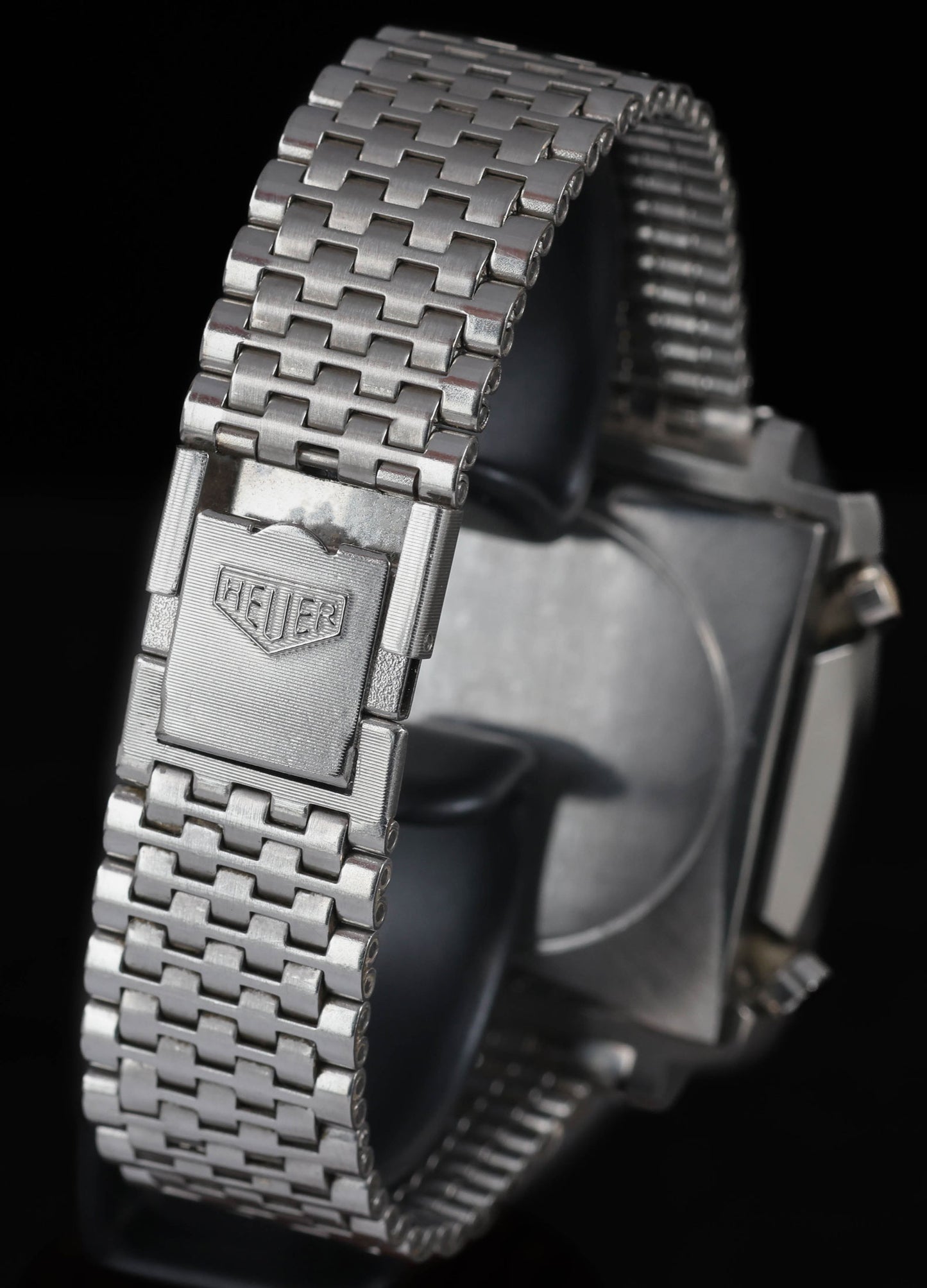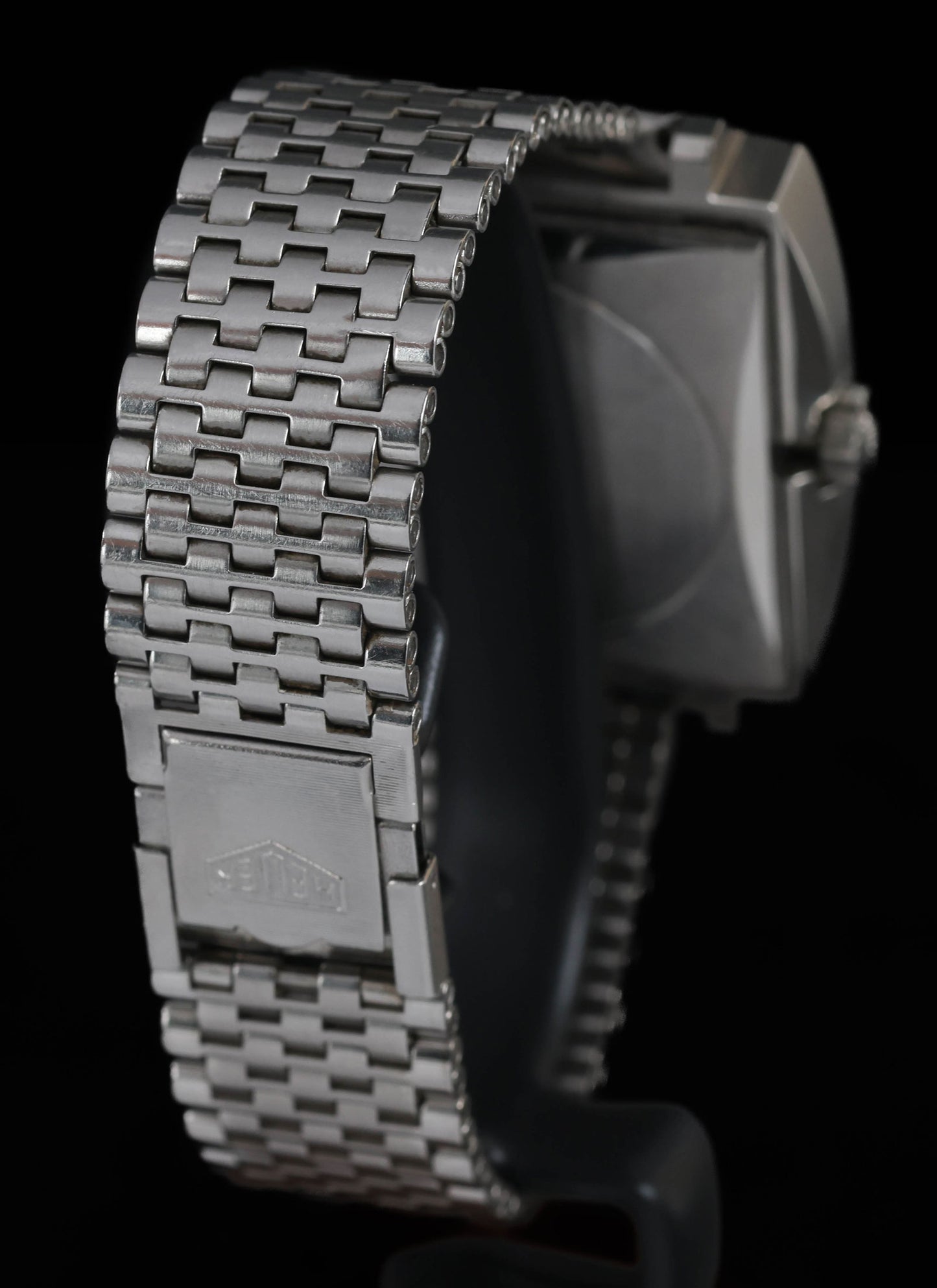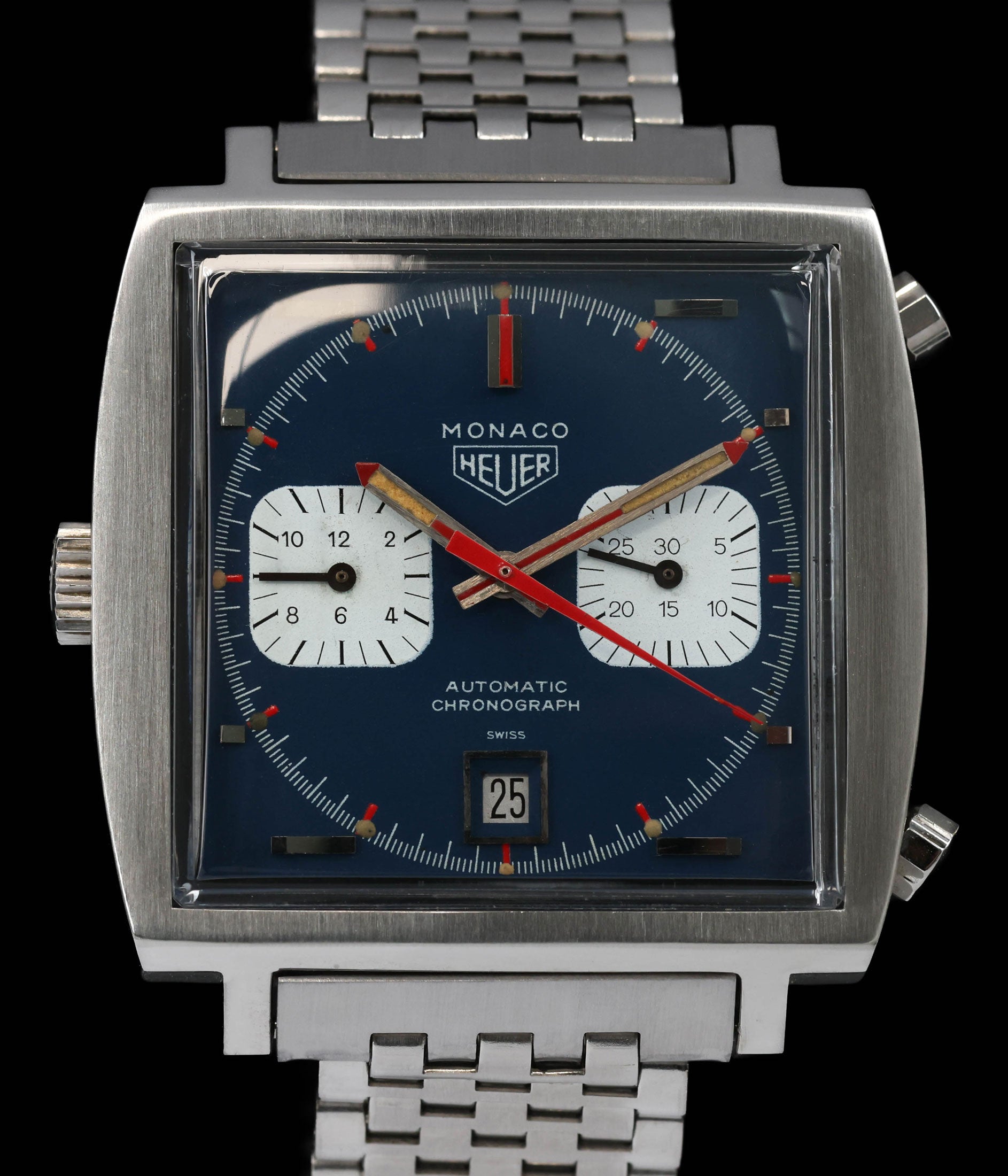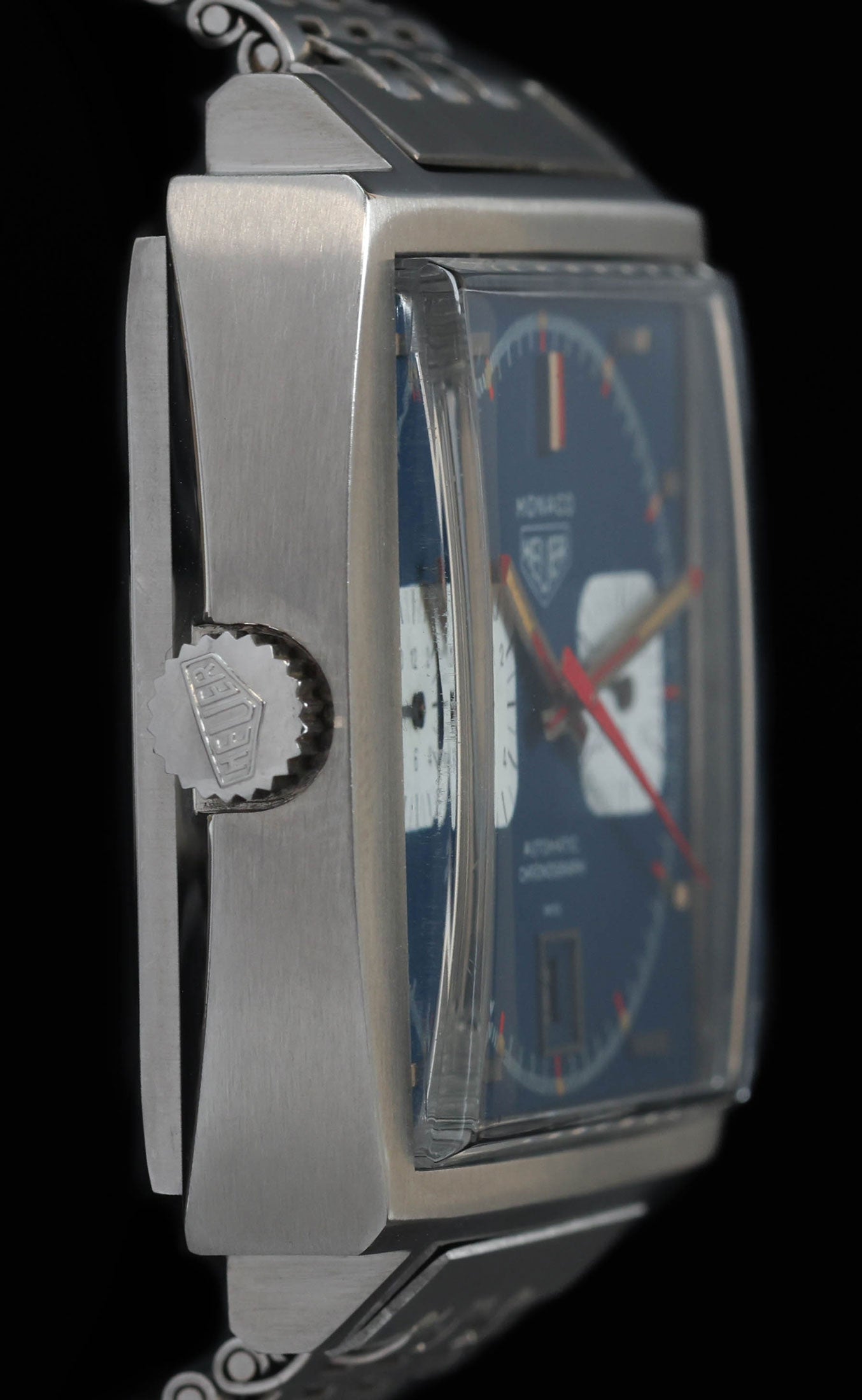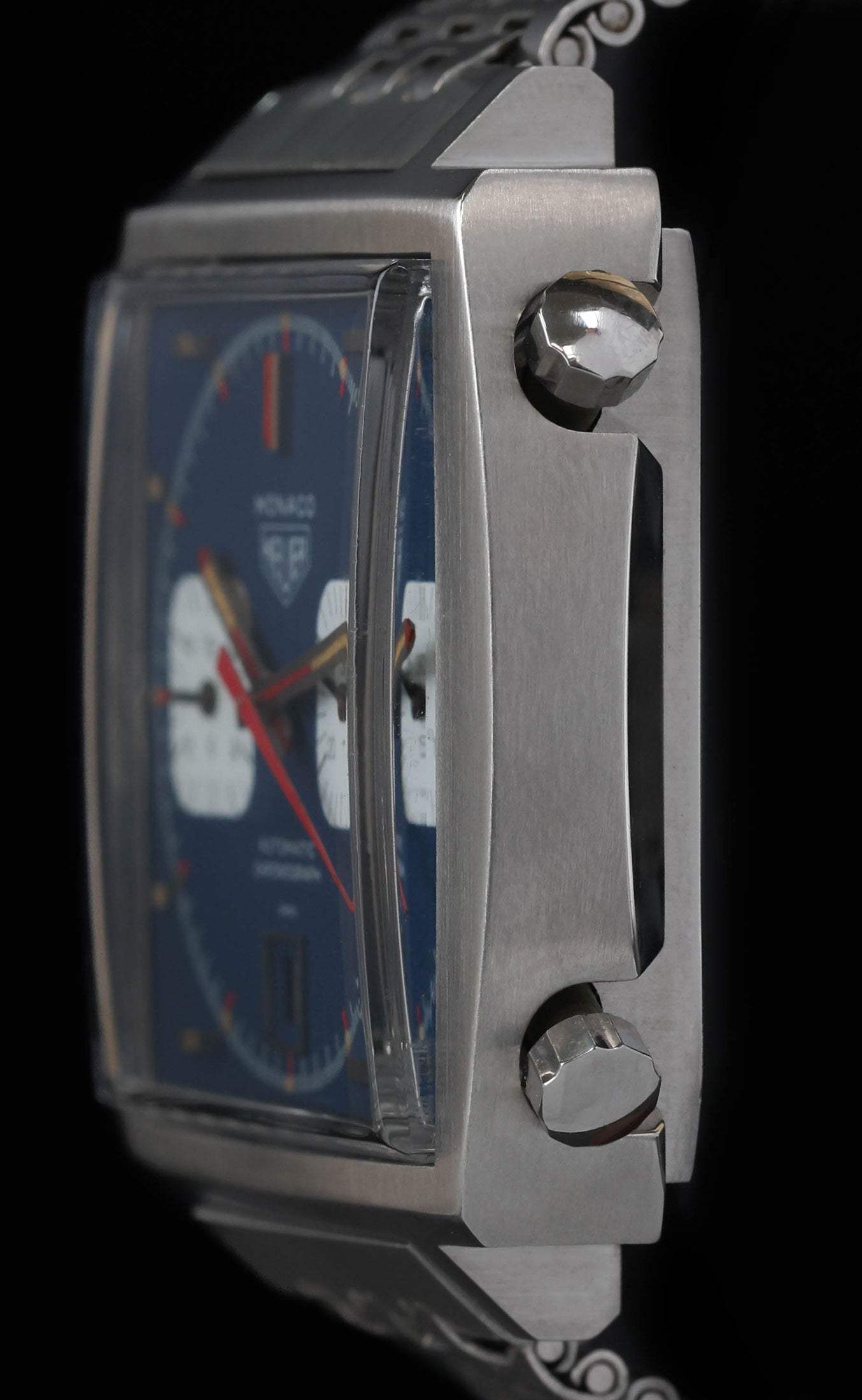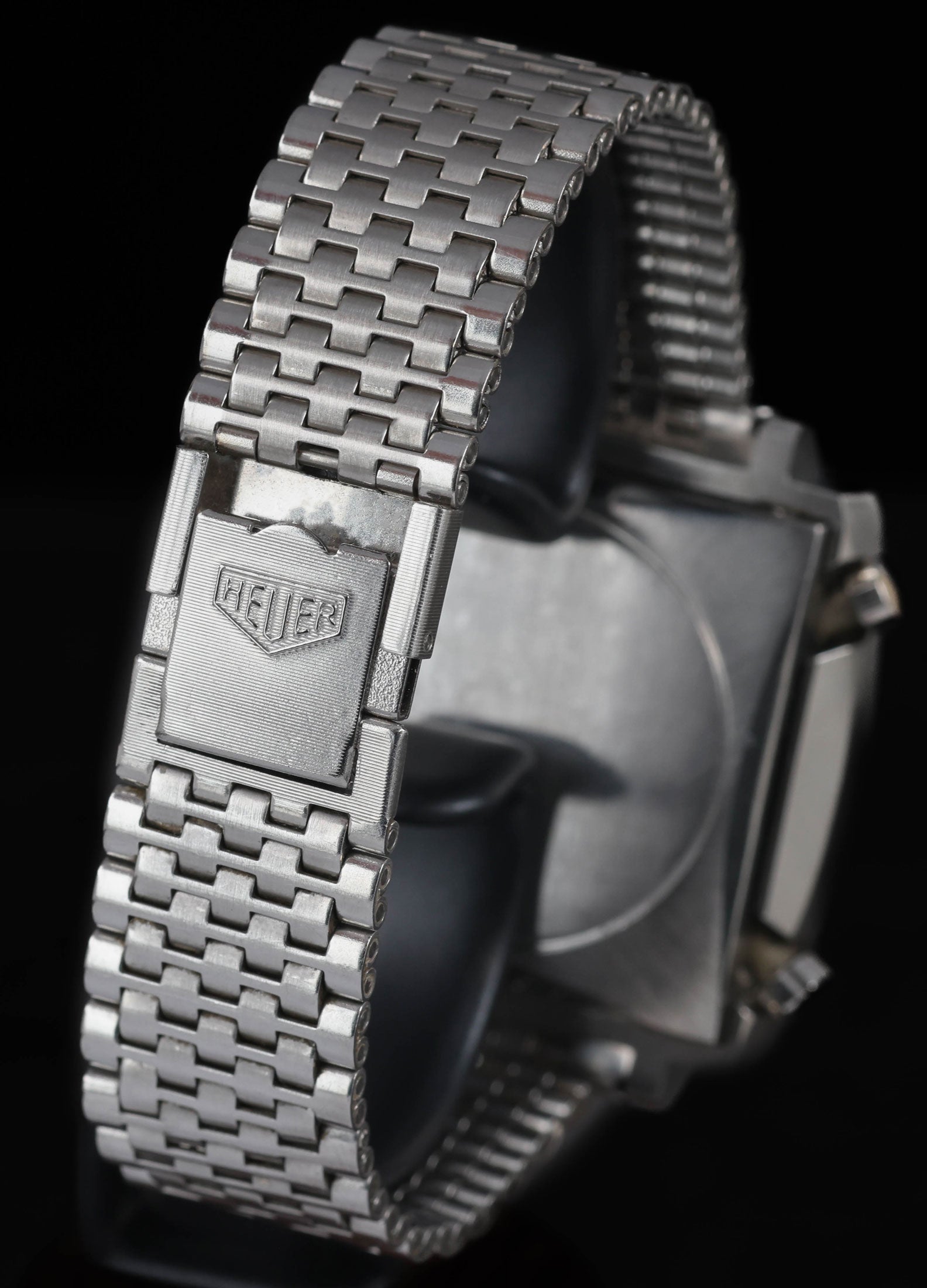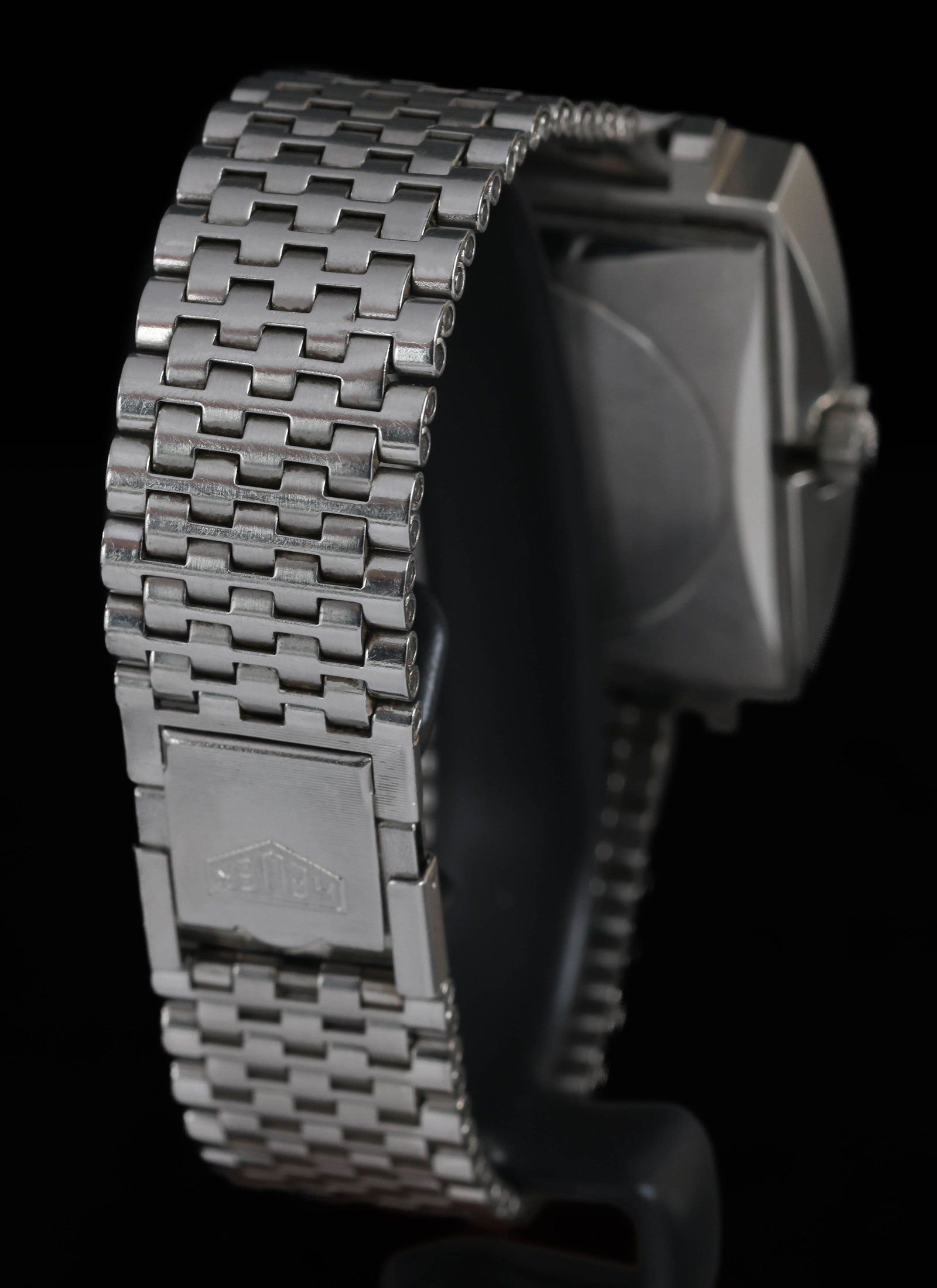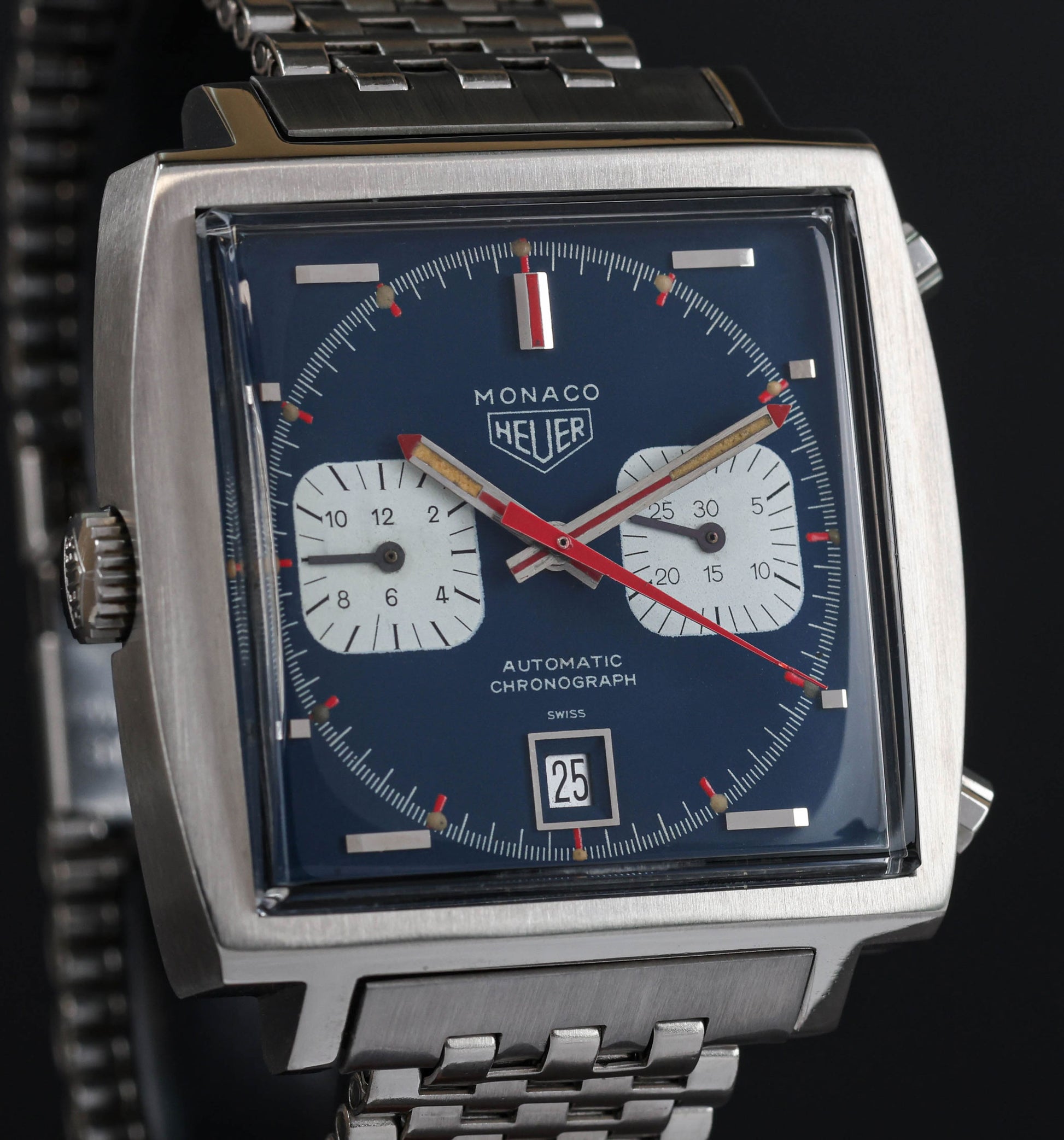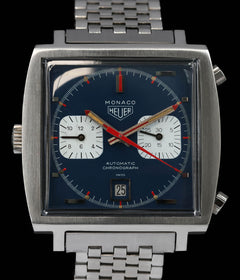Crown Vintage
Heuer Monaco 1133B 'Steve McQueen' 40mm Circa 1971
Heuer Monaco 1133B 'Steve McQueen' 40mm Circa 1971
Couldn't load pickup availability
Overall, this Heuer Monaco 1133B presents exceptionally well, with its case standing out for its sharpness and well-maintained features. The case is in excellent condition, displaying sharp edges and well-preserved original proportions. The finishing remains crisp, with polished and brushed surfaces clearly defined. The bracelet is in good condition, showing light signs of wear consistent with age but retaining its structural integrity and overall appearance. The dial and hands are in good condition, maintaining clear legibility and original detailing. Lume plots are intact with minor patina, adding to the watch’s vintage character.
Share
Why we love this watch
Why we love this watch
Heuer Monaco 1133B: A Detailed Examination of the Square Chronograph’s History, Features, and Steve McQueen Connection
The Heuer Monaco 1133B is one of the most innovative and recognisable chronographs in the history of watchmaking. Released in 1969 as part of Heuer’s effort to introduce the world’s first automatic chronograph, the Monaco was revolutionary not only for its technical features but also for its unconventional, angular design. Its association with actor Steve McQueen in the 1971 film Le Mans has only heightened its significance, making it a sought-after piece with strong historical importance.
The 1133B reference, specifically the blue-dial variant, remains the most iconic iteration of the Monaco model. Its distinctive case shape, dial layout, and use of the Caliber 11 movement make it a standout piece within the Heuer lineup.
The Race to Create the First Automatic Chronograph
During the late 1960s, several prominent watch manufacturers were engaged in a competitive race to produce the world’s first automatic chronograph movement. This technological milestone was considered the next major advancement in horology, as it would combine the practicality of a self-winding mechanism with the complexity of a chronograph function.
Three separate groups were working independently toward this goal:
- Zenith: Developed the El Primero, an integrated automatic chronograph movement operating at a high beat rate of 36,000 vibrations per hour. Released in January 1969, the El Primero was notable for its precision and integrated design, housing the chronograph and automatic winding mechanisms within a single movement.
- Seiko: Focused on developing the Caliber 6139, which was released exclusively in Japan. This automatic chronograph was integrated, featuring a column-wheel mechanism and vertical clutch, considered highly advanced for its time.
- Chronomatic Group: A consortium consisting of Heuer, Breitling, Hamilton-Buren, and Dubois-Depraz. This group’s approach utilised a modular construction, combining a Buren base movement (featuring a micro-rotor for efficient winding) with a chronograph module designed by Dubois-Depraz. The resulting movement was known as the Caliber 11.
The Heuer Monaco 1133B was one of the first watches released featuring the Caliber 11 movement. Its launch was part of a broader effort by Heuer to introduce automatic chronographs to the market, alongside models such as the Autavia and Carrera.
The Caliber 11 Movement
Design and Technical Specifications
The Caliber 11 was officially launched on 3rd March 1969 during simultaneous press conferences held in Geneva and New York. As the first automatic chronograph movement developed by the Chronomatic Group, it represented a significant technological achievement.
Unlike Zenith’s El Primero, which utilised an integrated movement architecture, the Caliber 11 employed a modular construction. This approach allowed Heuer and its partners to combine the existing Buren base movement with a chronograph module manufactured by Dubois-Depraz.
The Buren movement featured a micro-rotor winding system, which offered several advantages:
- Reduced Thickness: The micro-rotor was integrated into the movement plate, resulting in a slimmer profile compared to traditional full-rotor designs.
- Efficient Winding: The micro-rotor enabled bidirectional winding, enhancing energy transfer to the mainspring.
The chronograph module added by Dubois-Depraz utilised a cam-actuated mechanism rather than a column wheel. This decision was likely made to simplify production and reduce costs, though it also affected the feel of the pushers when engaging the chronograph functions.
Technical Specifications of the Caliber 11
- Movement Type: Automatic, modular chronograph
- Frequency: 19,800 vibrations per hour (2.75 Hz)
- Power Reserve: Approximately 42 hours
- Jewels: 17
- Chronograph Functions: Central seconds hand, 30-minute counter, 12-hour counter (in certain models, but not the Monaco 1133B)
- Date Display: Positioned at 6 o’clock
- Winding System: Bidirectional micro-rotor
- Crown Position: Left-hand side of the case
The positioning of the crown on the left-hand side was a deliberate design choice, intended to signal that the watch did not require manual winding. This was considered a novel and progressive feature at the time, highlighting the automatic nature of the movement.
Design Characteristics of the Heuer Monaco 1133B
The Heuer Monaco 1133B was visually distinctive upon release and remains one of the most recognisable chronographs ever made. The radical design departed from traditional round chronographs, opting instead for a bold, square case that measured 39mm in width.
Case Design
The case was manufactured by Ervin Piquerez S.A. (EPSA), a Swiss company renowned for its innovative waterproof cases. The Monaco’s square case was particularly challenging to make water-resistant due to its unconventional shape. EPSA’s solution resulted in a case rated to 30 metres of water resistance, which was considered adequate for everyday use but not suitable for serious diving.
The case featured a combination of polished and brushed finishes, with angular lugs that contributed to its geometric appearance. The acrylic crystal was flat with slight beveling around the edges, enhancing the watch’s unique aesthetic. Square pushers were positioned at 2 o’clock and 4 o’clock, operating the chronograph functions.
Production History and Variations
The Heuer Monaco 1133B was produced from 1969 to approximately 1975. During this period, several variations were introduced, primarily involving minor adjustments to the dial design, case finishing, and movement upgrades.
Early Production (1969 – 1971)
The earliest examples of the 1133B were fitted with the original Caliber 11 movement. These watches are identifiable by their low serial numbers, matte blue dials, and polished steel hands with luminous inserts. The hands on early models were typically straight, with a clean, angular appearance that complemented the square case.
During this period, the 1133B was produced alongside the grey-dialed 1133G, though the blue dial variant became far more popular due to its association with Steve McQueen. The initial production run was relatively limited, contributing to the model’s desirability among collectors today.
Transition to Caliber 12 (1971 – 1975)
Around 1971, Heuer began phasing out the Caliber 11 in favour of the improved Caliber 12. The newer movement featured an increased beat rate of 21,600 vibrations per hour, providing enhanced accuracy and reliability. It also addressed some of the mechanical shortcomings of the original Caliber 11, particularly in terms of shock resistance and overall robustness.
The Caliber 12 models retained most of the visual characteristics of the earlier 1133B references, though some subtle changes were introduced over time. The most noticeable difference was the increased smoothness of the seconds hand due to the higher beat rate.
By the mid-1970s, Heuer discontinued production of the Monaco 1133B, primarily due to poor commercial performance. The unconventional design, while innovative, was too radical for mainstream acceptance. Additionally, the emergence of quartz technology had begun to erode the market for mechanical chronographs.
Steve McQueen and Le Mans (1971)
Background and Film Production
The Heuer Monaco 1133B’s association with Steve McQueen is arguably the most important factor contributing to its enduring popularity. This connection was established during the production of Le Mans (1971), a film that depicted the intensity and drama of the 24 Hours of Le Mans endurance race.
McQueen, a dedicated motorsport enthusiast, was meticulous about authenticity in his portrayal of racing driver Michael Delaney. He enlisted the help of professional drivers, including Jo Siffert, to ensure the film’s realism. Siffert, who had been sponsored by Heuer since 1969, wore a Heuer chronograph during races and had developed a strong relationship with the brand.
During the filming of Le Mans, McQueen’s wardrobe required an appropriate chronograph to complete his racing driver look. The Heuer Monaco 1133B was selected, reportedly because it was the only Heuer model available on set at the time.
Why McQueen Chose the Monaco
The choice of the Monaco 1133B was somewhat fortuitous. McQueen could have worn a Carrera or Autavia, both of which were popular among drivers. However, the bold, unconventional design of the Monaco likely appealed to McQueen’s preference for distinctive style. Additionally, the bright blue dial and square case made the watch stand out on camera, enhancing its visibility.
McQueen wore the Monaco throughout the film, prominently featured during racing scenes and close-ups. The association between McQueen and the Monaco 1133B was solidified by promotional materials, which depicted him wearing the watch in various posters and publicity photographs.
Although Le Mans was not a commercial success upon its release, it has since gained cult status among motorsport fans. The presence of the Heuer Monaco 1133B on McQueen’s wrist played a significant role in the watch’s legacy, earning it the enduring nickname “The McQueen Monaco.”
Modern-Day Collectability and Market Value
The Heuer Monaco 1133B is now considered a highly sought-after collector’s item, particularly when found in original, unmodified condition. Collectors place significant value on early examples featuring the Caliber 11 movement, matte blue dials, and polished steel hands.
The watch’s association with Steve McQueen remains a significant factor in its desirability. Collectors often refer to the 1133B as the “McQueen Monaco,” and this connection has only grown stronger over time. The watch’s prominent appearance in Le Mans is often cited as one of the greatest examples of product placement in cinematic history, even though it occurred organically rather than through a formal endorsement.
Factors Affecting Collectability
- Movement Type: Early models featuring the original Caliber 11 are generally more desirable than later pieces fitted with the Caliber 12.
- Dial Condition: Watches with original, unmodified blue dials are particularly valuable. Faded or discoloured dials are accepted, provided they display natural patina rather than damage from water or improper servicing.
- Case Condition: The square case is prone to scratches and dents, so well-preserved examples are rare. Collectors prefer cases that retain their original proportions and finishes.
- Provenance: Watches with documented links to Steve McQueen or those featured in Le Mans memorabilia are considered exceptionally valuable.
Market Trends
Prices for original Heuer Monaco 1133B models have appreciated significantly over the past two decades. Well-preserved examples regularly sell for tens of thousands of dollars at auction, with particularly rare or documented pieces fetching considerably higher sums.
In 2020, one of the actual Heuer Monaco 1133B watches worn by Steve McQueen during the filming of Le Mans was sold at auction for a record-breaking $2.2 million. This sale cemented the model’s status as the most valuable Heuer watch ever sold, further boosting interest in the reference among collectors.
Conclusion
The Heuer Monaco 1133B is one of the most important and recognisable chronographs ever produced. Its bold design, pioneering automatic chronograph movement, and connection to Steve McQueen have ensured its place in horological history. While modern iterations of the Monaco continue to evolve, the original 1133B remains the quintessential reference, revered for its groundbreaking approach and enduring cultural impact.
From its introduction in 1969 to its ongoing legacy in contemporary watchmaking, the Heuer Monaco 1133B exemplifies the intersection of design, innovation, and popular culture. As collectors continue to seek out early examples of this legendary model, its status as a timeless icon remains unchallenged.
Case & Bracelet
Case & Bracelet
- Case is in excellent condition and very sharp. Bracelet is in good condition.
Dial & Hands
Dial & Hands
Dial and hands are in good condition.
Warranty & Condition
Warranty & Condition
Crown Vintage Watches provides a minimum 3-month mechanical warranty on pre-owned watches, from the date of purchase.
The warranty covers mechanical defects only.
The warranty does not cover damages such as scratches, finish, crystals, glass, straps (leather, fabric or rubber damage due to wear and tear), damage resulting from wear under conditions exceeding the watch manufacturer’s water resistance limitations, and damage due to physical and or accidental abuse.
Please note, water resistance is neither tested nor guaranteed.
Shipping and insurance costs for warranty returns to us must be covered by the customer. Returns must be shipped via traceable courier. Return shipment must be pre-paid and fully insured. Collect shipping will be refused. In case of loss or damages, the customer is liable.
Our Pledge
At Crown Vintage Watches, we stand by the authenticity of every product we sell. For added peace of mind, customers are welcome to have items independently authenticated at their own expense.
Condition
Due to the nature of vintage timepieces, all watches are sold as is. We will accurately describe the current condition and working order of all watches we sell to the best of our ability.
Shipping & Refund
Shipping & Refund



